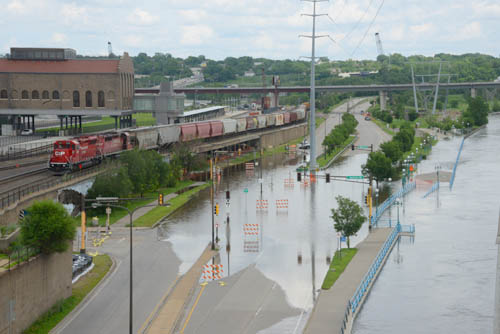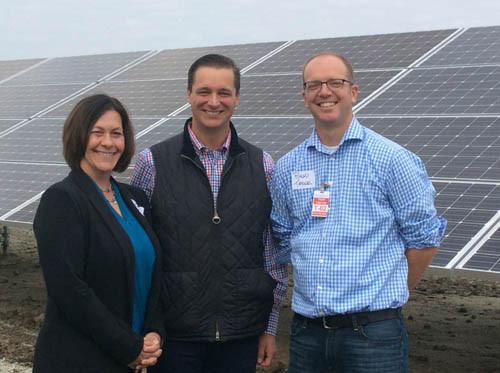Dr. Mark Seeley of the University of Minnesota didn’t mince words when he presented a summary of his research on Minnesota climate change to the Metropolitan Council in early March.
Seeley, a well-known climatologist and public educator on climate change, was invited to the Council as part of a larger discussion on ways the state and the region are responding to climate change.
“I can tell you emphatically and without reservation that our climate is changing, and changing at a remarkable pace,” he said in serious but radio-friendly tones familiar from his many appearances on local media. “But it’s also having significant consequences already.
“Our data (dating back to 1850) is screaming at us, literally, that our climate is changing,” he said dramatically. “And with each passing month and year and decade, we are recording more and more measurements of our climate system that are outside our historical extremes.
“My fundamental message to you as the Metro Council is that you, along with other public leadership that guides our citizenry and helps insure that we have workable, working infrastructure, need to pay attention to this message. Because this is an important message for all of us.”
Seeley’s comments, while not new, provided a sober reminder about the importance of long-range planning to meet future challenges in the metro area.
For more than a decade, the Council has been working to reduce its greenhouse gas emissions. Both the Council’s Environmental Services division and Metro Transit have already achieved significant energy conservation and continue make progress.
Collaborating with state, regional and local partners
 Seeley’s comments also underscore the reason the Council has embarked on new initiatives that specifically address current and future impacts of climate change – work that affect the Council’s public operations (transit, wastewater treatment, parks, etc.) as well as the agency’s work with other units of government.
Seeley’s comments also underscore the reason the Council has embarked on new initiatives that specifically address current and future impacts of climate change – work that affect the Council’s public operations (transit, wastewater treatment, parks, etc.) as well as the agency’s work with other units of government.
In a presentation following Seeley, Local Planning Assistance Manager Lisa Barajas said Council staff have developed new connections with other levels of government to prepare for the most likely outcomes of climate change in the near future. Council staff also are taking a close look at the ways climate change might impact Council operations.
“First, we want to work with and support our region-wide and state partners to build resilience to climate change,” she said.
Barajas said the Council is collaborating on climate impacts with such agencies as the state Environmental Quality Board, Interagency Climate Adaptation Team, Metropolitan Energy Policy Coalition, State Climatology Office, U.S. Forest Service, Clean Air Minnesota, Clean Energy Resource Teams, and other state, county and local agencies.
Assessing vulnerability of regional assets
An overarching initiative is the Climate Vulnerability Assessment – a systematic evaluation of regional assets and systems potentially impacted by climate change.
 “What does climate change look like for regional assets, and what strategies do we propose to address those vulnerabilities?” Barajas asked.
“What does climate change look like for regional assets, and what strategies do we propose to address those vulnerabilities?” Barajas asked.
Council staff in Environmental Services are already developing hazard mitigation plans for the facilities to address threats like flooding, to assure public safety, employee safety, and to protect infrastructure.
“We’re digging deeper into our own systems and finding the geography where we’re most likely to have problems impacting our transit system, wastewater infrastructure, parks and other regional assets,” Barajas said.
“Where are these hotspots and how frequently might we encounter problems? Can we mitigate problems, or do we need to adapt – or even move facilities to new locations?
“We hope that by getting in front of this we can learn our own lessons and translate our experience and strategies to local government,” she said.
Technical assistance on climate change for local communities
On a parallel track, Council staff are reaching out with new kinds of technical assistance for local communities.
“A big part of our role as a regional resource is reaching out to support local units of government as they plan ahead for future climate impacts – for example, helping communities assess their vulnerabilities and planning ahead to address them, and helping communities make the most of their Comprehensive Development Plans.”
The Council’s new Local Planning Handbook (LPH) includes specific guidance on resilience and how planning for climate change can be incorporated into a community’s Comprehensive Plan.
LPH resources will include model ordinances, model policies, and examples of best management practices that address local vulnerabilities.
“We’re also tapping into national resources on climate change and sharing information with local communities that has the most impact and most applicability for Minnesota communities,” Barajas said.
New training series for local government, ‘PlanIt,’ coming this summer
In summer 2016, the Council will launch “PlanIt,” a comprehensive planning workshop series on community planning that will include specific training about incorporating climate mitigation and adaptation measures into local development plans.
“PlanIt will, I think, be extremely valuable as local communities really dig into the local issues they each will face on these issues in the years ahead,” Barajas said.
“We have a lot to face. How are we going to plan appropriately and in the best ways possible to mitigate these problems, or adapt to them, in our everyday planning?
“We are already aware of the impact of climate change on our local infrastructure today, and as Dr. Seeley pointed out, we know there will be even greater impacts in the future,” Barajas said.
More about the Council’s Local Planning Assistance.